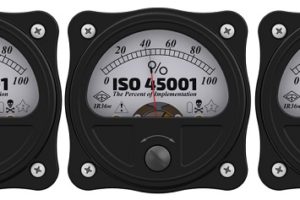In yesterday’s Advisor, we provided a brief overview of the soon-to-be published ISO 45001 occupational safety and health management standard and provided the first part of an interview with Chris J Ward, an International Organization for Standardization (ISO) 45001 specialist. Today we continue the interview with Chris with a focus on possible problematic areas and benefits for EHS managers in U.S. companies.
Advisor: How do you expect the ISO 45001 requirement to understand the “marketplace” and a business’s position in that marketplace to be received by the safety community worldwide? Although a very worthwhile goal, it seems like an onerous undertaking for your “on-the-floor” EHS manager who will likely be tasked with developing the information.
Chris: The marketplace is addressed in the standard by the Context clause. This and the increased emphasis on leadership are key changes from [Occupational Health & Safety Advisory Services] OHSAS 18001. The health and safety community will welcome the role of enhanced engagement by leaders. Big changes to improving health and safety will not occur without the full backing of top management. However, achieving effective engagement will not be easy, safety practitioners may have to develop new negotiation skills, and auditors will need to similarly become competent at assessing top management involvement.
Advisor: Our audience is primarily EHS managers at U.S. companies. According to ISO in its 2016 survey, a total of 1,643,523 valid certificates were recorded across nine standards. Over 1.1 million were for ISO 9001 and over 346,000 for ISO 14001. In both cases, the overwhelming numbers were from Europe and East Asia/Pacific (over 80%, over 90%, respectively). Only 4% and 2.4%, respectively, were from U.S. companies. It is well-known that U.S. companies are not drawn to certifying to the standards because of the bother and the expense. Is there a carrot in ISO 45001 that would draw U.S. companies in—especially small to medium businesses?

Chris J Ward (right) and David Smith, Chair of the ISO 45001 committee and responsible for creating the standard.
Chris: Hitherto, U.S.A. has primarily worked to [American National Standards Institute] ANSI Z10. There is a commitment to ISO by National Standards’ Bodies that ISO standards will be enacted/adopted by NSBs (i.e., National Standards Bodies). [The American Society of Safety Engineers] ASSE, representing the USA, has been involved at all stages in the standard’s development. This will be one driver for organisations to be attracted to this ISO. Nevertheless, because this is a truly global standard, it will increasingly become the accepted norm. Note for those already compliant to an integrated standard, such as ISO 14001, some key steps to achievement will have already been taken. One advantage is that truly global organisations, wherever they are based, will be able to trade on the same occupational health and safety performance requirements, and as such, barriers to cross border trading will be reduced. And the standard has been developed to provide flexibility and reduce resource requirements to [subject matter experts] SMEs, for instance, the requirement to produce extensive documents and procedures has been removed, replaced by options that include multimedia evidence such as a photograph of safety performance on-site.
Advisor: Are there any data that you are aware of that show that U.S. companies have lost business in the global marketplace because of lack of certification to international standards?
Chris: I am not aware of any data in the U.S.A. But it is increasingly the case that the supply chain is assessing [occupational health and safety] OHS performance in their due diligence enquiries. And the Global Reporting Initiative is to include OHS performance in future. Check here for some background.
Advisor: One of the benefits touted for ISO 45001 is the flexibility in both documentation and certification. There are components of ISO 45001 that allow for self-certification. However, if you do not use an accredited auditor, isn’t your certification essentially worthless?
Chris: Verification to the standard is provided in three ways. First-party audit is self-verification whereby the organisation completes an internal audit and declares conformity. Second-party audit is where an external organisation audits the organisation, such as a customer auditing a supplier. Third-party audit is with or without certification. The degree of confidence with these options is a risk assessment that observers need to make for themselves. Relationships in business are often based on trust, so there could be valuable associations between organisations. However, in an aggressive marketplace, let “the buyer beware” is the norm.
Advisor: We understand that those certified to OHSAS 18001 will have to migrate to ISO 45001 within 3 years of the 45001 publication date if they want to be certified to a safety management standard because 18001 will be discontinued. Is it the same for ISO 9001 and ISO 14001? Will they be discontinued?
Chris: When ISO 45001 is published, the British Standards Institute (BSI) will withdraw OHSAS 18001, but will continue to make certification available for a further 3 years, which will allow for organisations to transit. BSI and ISO are two entirely different standards makers. Transition to ISO 9001/14001 2015 (the most recent ISO standards for quality and environment, respectively) has to be completed by September 2018, or the organisation has effectively to start its certification process afresh.
 Chris J Ward, CMIOSH, is an ISO 45001 specialist and an author and lead auditor for OHSAS 18001. He was a principal inspector with U.K.’s Health and Safety Executive (HSE) for 36 years and has experience with a wide range of manufacturing and service sectors. Chris is the author of HSE’s audit tool for inspection of health and safety management used by HSE and local authority inspectors in the U.K. He continues to investigate fatal accidents around the world in the heavy manufacturing and construction sectors. Chris can be reached at chrisjward@iso45001assessment.com. Chris J Ward, CMIOSH, is an ISO 45001 specialist and an author and lead auditor for OHSAS 18001. He was a principal inspector with U.K.’s Health and Safety Executive (HSE) for 36 years and has experience with a wide range of manufacturing and service sectors. Chris is the author of HSE’s audit tool for inspection of health and safety management used by HSE and local authority inspectors in the U.K. He continues to investigate fatal accidents around the world in the heavy manufacturing and construction sectors. Chris can be reached at chrisjward@iso45001assessment.com. |

